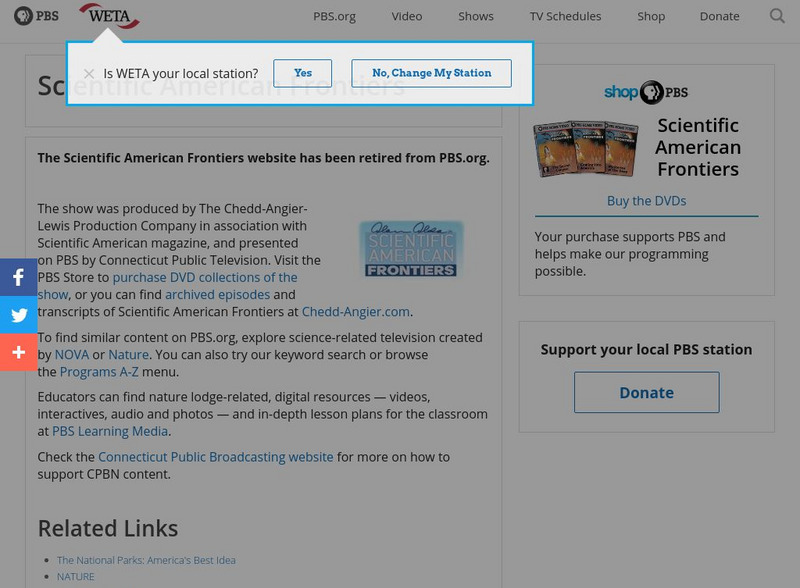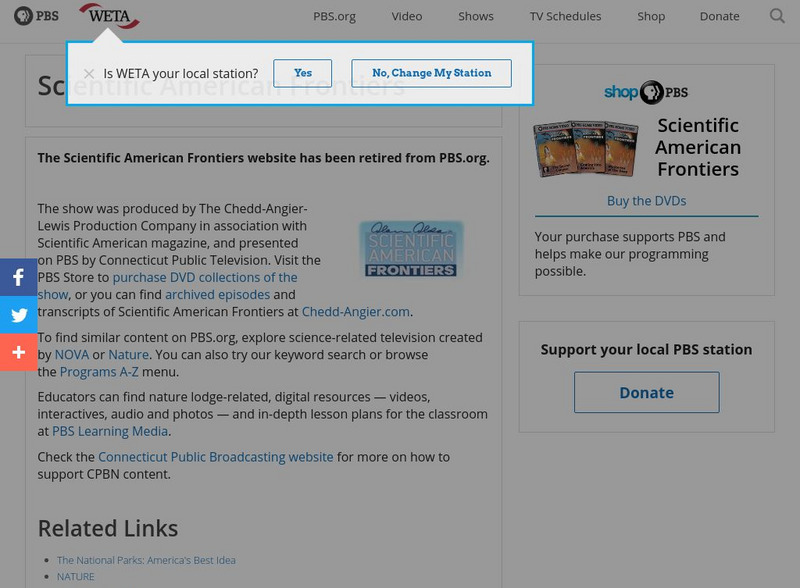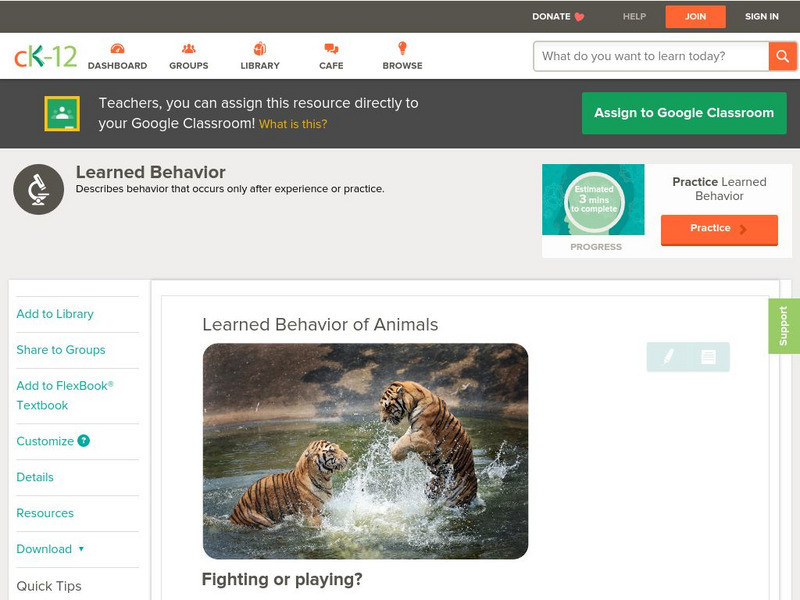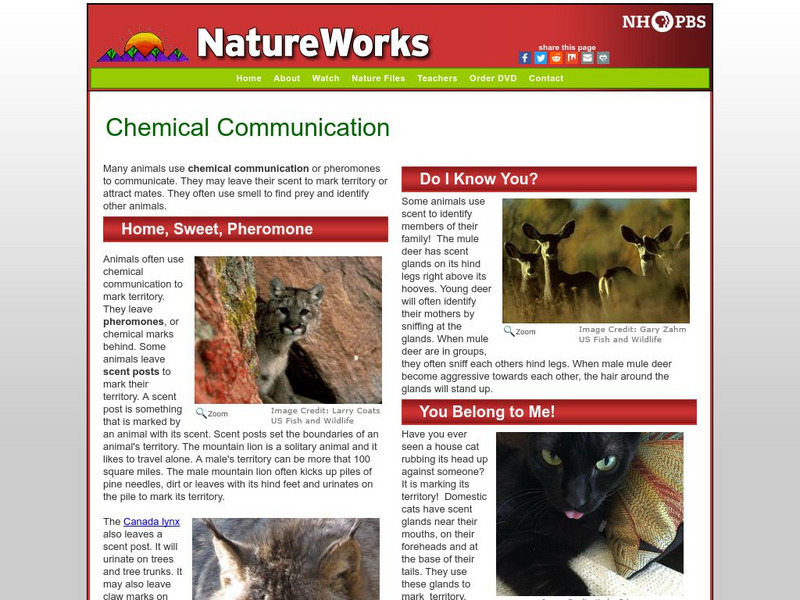Songs for Teaching
Sciences Songs All Day Long: Nocturnal Animals
By listening to this song your students will learn all of the animals that are awake during the night. They will equate the sounds they hear at night with the animals and their sounds in the song.
PBS
Pbs Teachers: Scientific American: Chimps R Us: Understanding Travel Routes
Examine a map of the travel routes and evening nesting sites of two chimpanzees and create a travel route of your typical day. Describe the social enhancements that helped humans to evolve from foraging behavior to establish fixed...
PBS
Pbs Teachers: Scientific American: The New Zoos: Polar Bear Picnic
Explore zoos and the change in animal care, and research the physiology and habitats of polar bears. Investigate the difference between what is essential to survive and what is desirable in an enriched environment.
PBS
Pbs Teachers: Scientific American: The New Zoos: Return to the Wild
Explore the history of zoos, and design blueprints for an enriched "new zoo." Research genetic problems in captive animals.
PBS
Pbs Teachers: Scientific American: The New Zoos: Tuna in the Tank
Investigate how scientists track the world's most valuable and endangered fish. Define the range of an individual based on observations made over the course of a day.
PBS
Pbs Teachers: Scientific American: Animal Einsteins: Figure That One Out
Investigate problem-solving techniques by using observation and data analysis skills. Observe how different people solve the same puzzle and make conclusions about how humans and animals think.
PBS
Pbs Teachers: Scientific American: Animal Einsteins: If Only They Could Talk!
Investigate the communication skills of animals. Explore their ability to associate abstract concepts or signs with specific objects or actions by solving a puzzle involving decoding symbols.
PBS
Pbs Teachers: Scientific American: Animal Einsteins: Thinking About Thinking
Investigate the work of ethologists - animal behaviorists - by observing an animal's behavior (alone and then in a group) for an extended period of time. Produce a scientific report of your observations.
PBS
Pbs Teachers: Scientific American: Animal Einsteins: Who Needs Words, Anyway?
Explore the theory that animals can learn to comprehend abstract concepts by observing to see if specific animal calls are associated with specific actions. Use scientific observation and record-keeping to collect and analyze data.
PBS
Pbs Teachers: Scientific American: Prime Time Primates: Chimps Count
Explore the techniques and steps in training an animal by attempting to train a classmate to perform a simple task without using known words. Train him or her to respond to a vocabulary of nonsense words with hidden meanings.
PBS
Pbs Teachers: Scientific American: Prime Time Primates: Finger Food
Research two species of primates, the lemur and the aye-aye, to discover their survival strategies and adaptive behaviors. Select another primate species to investigate and work in a cooperative group to gather information from many...
Sophia Learning
Sophia: Immigration and Emmigration: Lesson 5
This lesson will introduce immigration and emmigration, and explain the effects both can have on a community.
PBS
Pbs: Nature: Animals and People: Who's Behaving Badly?
Explore the great variety of animal behaviors by observing them in their natural habitats, and examine the relationship between people, animals and the environment.
Smithsonian Institution
Smithsonian National Zoo: Meet Our Animals
This site from the National Zoological Park provides extensive information about many types of animals. Just click on the category you need. Includes pictures and live web cams.
CK-12 Foundation
Ck 12: Biology: Learned Behavior of Animals
[Free Registration/Login may be required to access all resource tools.] Describes types of behavior that animals can learn.
PBS
Pbs Teachers:kakadu: Animal Behaviors
Discuss animal behaviors and relate them to human behaviors and predict how animals may behave based on their physical characteristics.
PBS
Pbs Teachers: Scientific American: Prime Time Primates: The Mating Game
Emulate the work of primatologists by observing animals in a zoo environment. Record observations as entries in a journal, and prepare a final report of your conclusions.
Science and Mathematics Initiative for Learning Enhancement (SMILE)
Smile: Animal Behavior
Lesson plan that allows students to investigate the effect of water temperature on fish behavior. Students measure, collect data, and interpret the results.
PBS
Nh Pbs: Nature Works: Chemical Communication
This site deals with many animals' use of chemical communication or pheromones to communicate. Includes examples and pictures.
PBS
Nh Pbs: Nature Works: Visual Communication
When animals exhibit behaviors or characteristics that can be seen by other animals, the process is called visual communication. This site explores this concept and gives examples.





















